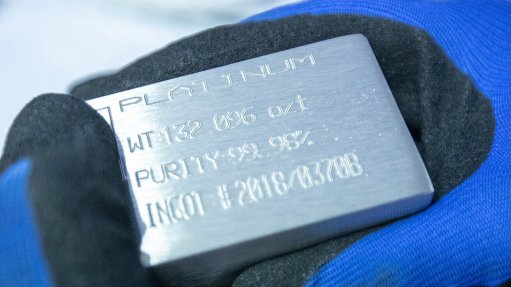Market recognising higher likelihood of platinum deficit than surplus in years ahead – WPIC

The market is recognising the higher likelihood of platinum being in deficit rather than in surplus in the mid-term years ahead, said World Platinum Investment Council research director Trevor Raymond on Thursday.
JOHANNESBURG (miningweekly.com) – Right now, the market is recognising the higher likelihood of platinum being in deficit rather than in surplus in the mid-term years ahead, said World Platinum Investment Council (WPIC) research director Trevor Raymond on Thursday.
Raymond expects pent-up consumer demand for vehicles to reduce any surplus, along with the substitution of platinum for palladium, which he describes as being "very material". (Also watch attached Creamer Media video.)
“What we do know is that as soon as the automakers are able to resolve the semiconductor issue and chips start to flow, consumer demand hasn’t really gone away,” Raymond told Mining Weekly in a Zoom interview.
Despite the release of built-up platinum material that will come through this year and next, supply still has the word constraint written all over it in the years ahead.
“The delta variant isn’t doing as much harm as the market believed it might. There certainly is pent-up consumer demand, so as those chip shortages are resolved, which we actually think will take place in 2022, you might have higher estimates than are currently in place. That will certainly give you more demand and reduce any surplus,” said Raymond.
“So, other than in these two or three years, there’s certainly a far higher likelihood that platinum will be in deficit than in surplus, and we think that’s what the market is recognising right now,” Raymond reiterated.
“There's been a lot of concern about the semiconductor shortages and how they might impact certainly vehicle production and I think that’s played into negative sentiment towards platinum and palladium.
“Firstly, let’s just recall why there is this chip shortage. I think during the pandemic there’s been huge demand for electronic goods – iPads, screens, computers etc – so there’s been huge demand for these chips. There’s also been disruption to the global supply chain both in the manufacture and the distribution of those chips.
“In terms of vehicles, you know from your own vehicle that there’s been a proliferation of chips, with all sorts of things that can do all sorts of things, and I’ll come back to how automakers are trying to address that.
“But in general, we’ve had concerns about the number of vehicles being produced both from a semiconductor chip shortage point of view and just in terms of economic well-being and consumer preferences. What we’ve seen from organisations that forecast vehicle production is that predictions have been extremely volatile.
“They’ve been up and down and you’ve heard numbers thrown around of three, four, five, six, seven million fewer vehicles, and you need to be quite careful which vehicle group you’re looking at. But in general, we think there’s a swing of three to four million vehicles in the last few months. That certainly is relevant and we’ve tried to unpack what that means in terms of platinum group metals.
“We used Fitch forecasts because they’re the most public and available to investors, to anyone who wants to have a quick look and see; IHS are a little public but in general, we took both light duty and heavy duty vehicles and around about 85-million vehicles are to be produced in 2021, and that could then come down by two, or three or four million vehicles.
“What we’ve done is that if you believe that there will be a loss of about say three million vehicles from 85-million down to 82-million vehicles, what that means for platinum is a loss of about 35 000 oz of platinum per million vehicle production that is lost and that’s light duty and heavy duty,” said Raymond.
“If you look at palladium, you see that that loss is about 105 000 oz per million vehicle production that is lost. The reason is that there are more gasoline vehicles than diesel vehicles. Globally, there are about 20% diesel vehicles in the world and about 80% gasoline vehicles, so you would expect it to be more profound with palladium.
“If you take three million vehicles down in production, and this allows anybody to take their own view on what that loss is, and then multiply by 35 000 oz for platinum or 105 000 oz for palladium, that gives you the feeling. So, platinum down maybe 105 000 oz and palladium more 315 000 oz down.
AUTOMAKERS REDUCING OPTIONAL CHIP EXTRAS
“The other thing is what automakers can do about this. One thing they've done is to try and reduce the number of optional extras available, things like automatic handbrakes, when you can put on the brake pedal. That requires a chip, so they remove that optional extra and save a chip. So they’re doing as much as they can to use less chips on vehicles to be able to then finish the production and get them sold.
“The other thing they can do is that they can focus on their high-margin products, so heavy-duty vehicles, and certainly the large typically diesel SUVs in Europe – Daimler, Mercedes, Volvo – all of those are high margin and they've been focused on. What we believe is that the focus of the mix is towards the higher-margin vehicles as well as the larger vehicles. That certainly benefits platinum because a lot of those vehicles are platinum so, in our scenario, we believe that for that adjustment to the product mix, that the effect on platinum is that it will go down to about 28 000 oz per million vehicles, whereas for palladium it stays pretty much the same. It hardly changes.
“That’s the impact we’ve looked at. We’ll publish again on November 24. We’ll have detailed granular insights from LMC directly and we’ll model those and try and give you a more accurate impact on what we expect to happen in 2021, and then also going into 2022,” he added.
Mining Weekly: Is the chip shortage thus continuing to add less to this year’s over-supply estimates for platinum?
Raymond: Yes. I think the market has assumed, because of this chip shortage, that there will be much less demand for platinum and then the suggestion is that there will be a high surplus. So, we published most recently a surplus for the platinum market in 2021 of about 190 000 oz. In my argument of maybe 28 000 oz, that adds another 88 000 oz, so instead of a surplus of 190 000 oz, it's a surplus of 280 000 oz. That in itself certainly doesn’t warrant massive price reduction or huge negative sentiment. What we do know is that the opposite thing happening is that we do have a lot of substitution of platinum for palladium and certainly supply remains fairly constrained, so we think that that swing is, yes, material and, yes, of a concern, but certainly shouldn’t be harming sentiment.
So overall, what is the outlook for the medium term?
That outlook is going to be published by us on November 24. It will be the first time that we put out our forecast for the full 2022 and I can’t really front-run any of that data that we are still busy gathering. But in general, we’ve got two effects. I suppose on the semiconductors specifically, the views are that this initially was going to be resolved in 2021 and now it has run into 2022 and there are now real concerns that it might run right through 2022. What we do know is that as soon as the automakers are able to resolve issues and chips start to flow, consumer demand hasn’t really gone away. The fact that the delta variant isn’t doing as much harm as the market believed it might. There certainly is pent-up consumer demand so as those chip shortages are resolved, we actually think in 2022, you might have higher estimates than are currently in place. That will certainly give you more demand and reduce any surplus. The other thing is that we think the substitution is very material and supply is at best – we know we had that release of built-up material that will come through this year and next – in general, supply is still very much constrained. So, other than in these two or three years, certainly there is a far higher likelihood that platinum will be in deficit rather than in surplus and we think that’s what the market is recognising right now.
Article Enquiry
Email Article
Save Article
Feedback
To advertise email advertising@creamermedia.co.za or click here
Announcements
What's On
Subscribe to improve your user experience...
Option 1 (equivalent of R125 a month):
Receive a weekly copy of Creamer Media's Engineering News & Mining Weekly magazine
(print copy for those in South Africa and e-magazine for those outside of South Africa)
Receive daily email newsletters
Access to full search results
Access archive of magazine back copies
Access to Projects in Progress
Access to ONE Research Report of your choice in PDF format
Option 2 (equivalent of R375 a month):
All benefits from Option 1
PLUS
Access to Creamer Media's Research Channel Africa for ALL Research Reports, in PDF format, on various industrial and mining sectors
including Electricity; Water; Energy Transition; Hydrogen; Roads, Rail and Ports; Coal; Gold; Platinum; Battery Metals; etc.
Already a subscriber?
Forgotten your password?
Receive weekly copy of Creamer Media's Engineering News & Mining Weekly magazine (print copy for those in South Africa and e-magazine for those outside of South Africa)
➕
Recieve daily email newsletters
➕
Access to full search results
➕
Access archive of magazine back copies
➕
Access to Projects in Progress
➕
Access to ONE Research Report of your choice in PDF format
RESEARCH CHANNEL AFRICA
R4500 (equivalent of R375 a month)
SUBSCRIBEAll benefits from Option 1
➕
Access to Creamer Media's Research Channel Africa for ALL Research Reports on various industrial and mining sectors, in PDF format, including on:
Electricity
➕
Water
➕
Energy Transition
➕
Hydrogen
➕
Roads, Rail and Ports
➕
Coal
➕
Gold
➕
Platinum
➕
Battery Metals
➕
etc.
Receive all benefits from Option 1 or Option 2 delivered to numerous people at your company
➕
Multiple User names and Passwords for simultaneous log-ins
➕
Intranet integration access to all in your organisation



















